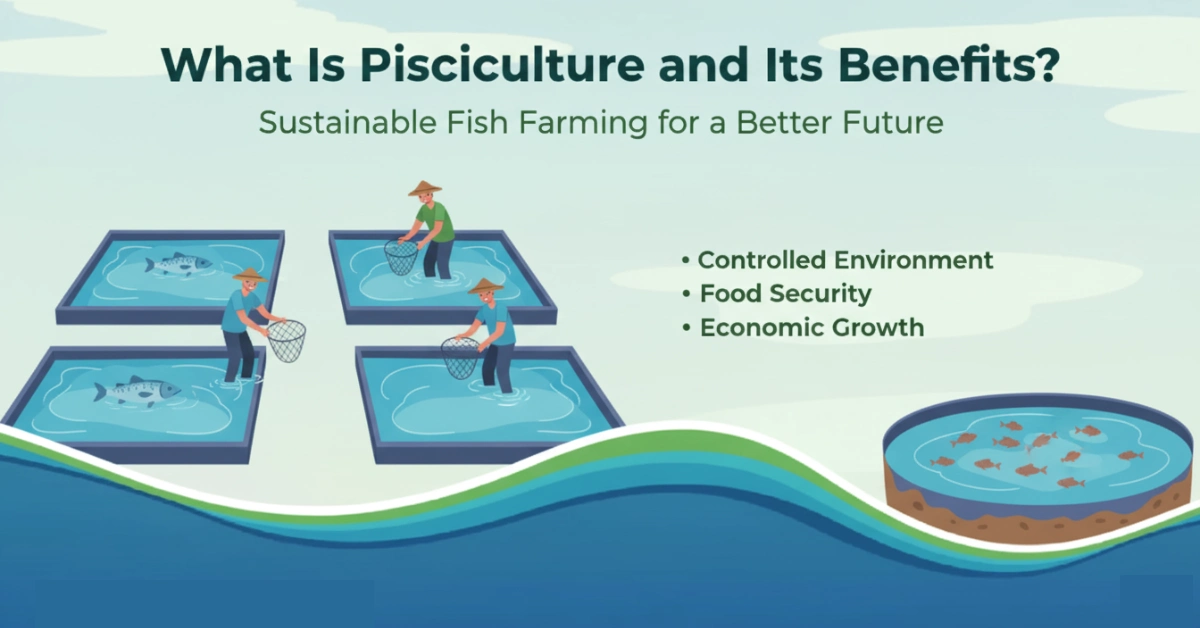India being home to a vast number of rivers, ponds, lakes and coastal areas makes it a perfect environment for fish farming. Within so many branches of modern agriculture, pisciculture is emerging as one of the most profitable and sustainable sources of livelihood, and that too for millions of farmers. Let us dive more into this and discover why it matters so much today.
What is Pisciculture?
If we talk in simple terms, then pisciculture is basically commercial fish breeding. Pisciculture refers to the practice of growing and transporting the fish for commercial and domestic purposes. The main goal of this practice is to increase the fish production to meet the growing demand for food, employment and income in rural and coastal communities.
There are other names as well for this practice, including mariculture and aquaculture. Now fish farming is a type of aquaculture in which aquatic organisms, like fish, crabs and molluscs, are skillfully tended to and harvested. Now this can either be done in a real-world natural environment, or a simulated one can be used as well.
Types of Pisciculture
There are many ways to classify pisciculture based on the environment and species that are being cultivated:
-
Freshwater Pisciculture
This method involves breeding the freshwater fish species like Catla, Rohu and Mrigal, which are commonly found in India, in ponds, lakes and rivers.
-
Brackish Water Pisciculture
This takes place in estuaries or the coastal lagoons where the seawater and freshwater mix. Some of the most popular species found are mullet, milkfish and seabass.
-
Marine Pisciculture
This involves rearing fishes in seawater or coastal cages. Species like pomfret, tuna and snapper are most commonly raised for commercial purposes.
-
Monoculture and Polyculture
Monoculture is the farming of a single fish species in one pond, and on the other hand, polyculture refers to the cultivating of multiple compatible fish species together in order to utilize all the ecological niches efficiently.
The Growing Scope of Pisciculture in India
India is said to be the second-largest producer of fish in the world. This sector plays a significant role in the Indian economy, providing over 14 million people with employment.
States that are the leading contributors to India’s fish production are Andhra Pradesh, West Bengal, Odisha and Kerala. There are many government schemes like Pradhan Mantri Matsya Sampada Yojana, which is further boosting investments, technology adoption and infrastructure in the fisheries sector.
Benefits of Pisciculture
This practice is contributing to the economic growth, nutrition security and environmental sustainability. The benefits of pisciculture go beyond just food production:
- High Nutritional Value: Fish are said to be a rich source of protein, omega-3 fatty acids, vitamins and minerals, which makes them one of the healthiest foods. Pisciculture here helps to ensure a steady supply of high-quality and affordable protein.
- Employment Generation: It provides people with livelihood opportunities for rural and coastal communities, especially for the small-scale farmers and women entrepreneurs.
Efficient Land and Water Use: Fish farming can be practiced in small ponds, tanks or even reservoirs, which makes use of land and water resources that otherwise might even remain underutilized. - Environmental Sustainability: If managed well, pisciculture supports sustainable resource use. The rice-fish farming, aka the integrated system, helps in weed control and nutrient recycling, which improves both soil and water quality.
- Export Opportunities: India’s fish exports especially the shrimp and freshwater fish exports, are said to contribute significantly to the nation’s foreign exchange which makes pisciculture an important part of the blue economy.
Challenges to Pisciculture
Now despite having so many benefits, there are some challenges as well that are faced during practicing pisciculture. Let us see what these challenges must be:
- Water Quality Management: In order to successfully practice pisciculture, it is important to maintain an optimal water quality, which is very crucial for fish health. Poor oxygen levels, pollution and contamination from agricultural runoff can cause many diseases and high mortality rates.
- Lack of Technical Knowledge: There are many small-scale farmers who do not hold proper knowledge of modern fish farming techniques, proper feed management and breeding practices, which in result leads to inefficiencies in production.
- Disease and Parasite Outbreaks: Fishes are susceptible to bacterial, viral and fungal infections, which can lead to inadequate biosecurity measures that will automatically result in significant economic loss.
- Inadequate Infrastructure: There are many farmers who have poor access to cold storage, transportation and market networks, which often prevents them from getting fair prices and maintaining product quality.
- Climate Change: We all know that India has the most unpredictable climate changes; sometimes it is the issue of fluctuating temperatures, irregular rainfall and changes in the water salinity due to all of this. This in turn affects the fish growth and breeding cycles.
Also read: A Complete Guide for Aquaponic Farming
Future of Pisciculture in India
We can say with full surety that the future of pisciculture in India looks very promising, that too with increasing demand for seafood and government initiatives promoting modernization.
Some of the key trends that are shaping the future include:
- Adoption of recirculating aquaculture systems for better water management.
- Integration of digital tools in order to monitor and feed optimization.
- Focus on sustainable aquaculture to reduce the environmental impact.
- Expansion of value-added products like fish fillets, frozen fish and fish oil.
If the farmers are provided with proper training, infrastructure and technological innovation, pisciculture can become a cornerstone of India’s rural development and food security strategy.

